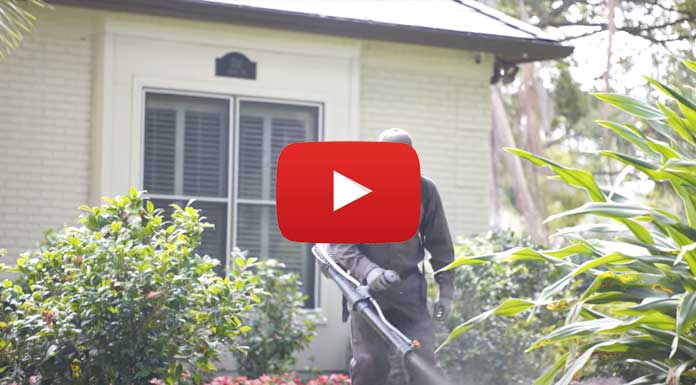Mosquito Control in Orlando – Safe Solutions for a Bite-Free Yard
This comprehensive mosquito control program will allow your family to enjoy spending time in the yard again and reduce the risk of being infected with viruses carried by these pests.
Mosquito Control Service Includes:
- Monthly applications to control mosquitoes during breeding season
- Treatment includes all plant material, shrub beds, and natural areas for the control of adult mosquitoes
- Professionally trained technicians to provide a safe and effective service
- Inspections performed to identify and treat breeding sites
- Additional mosquito treatments above and beyond the normal monthly visits will be charged the same as the monthly control service rate
- Environmentally friendly products and procedures

Environmentally Friendly Technicians
FAQ: Zika Virus
About Zika Virus
Zika is spread mostly by the bite of an infected Aedes species mosquito (Ae. aegypti and Ae. albopictus). These mosquitoes are aggressive daytime biters. They can also bite at night.
Zika can be passed from a pregnant woman to her fetus. Infection during pregnancy can cause certain birth defects.
There is no vaccine or medicine for Zika.
The Florida Department of Health has identified an area in one neighborhood of Miami where Zika is being spread by mosquitoes.
Preventing The Spread of Zika Virus
Prevent mosquito bites by using insect repellent, wearing long-sleeved shirts and long pants, using screens on windows and doors, and sleeping under a mosquito net when sleeping outdoors.
Once a week, empty and scrub, turn over, cover, or throw out items that hold water, such as tires, buckets, planters, toys, pools, birdbaths, flowerpots, or trash containers. Check inside and outside your home. Mosquitoes lay eggs near water.
Avoid traveling to regions affected by Zika, especially if you are pregnant or trying to become pregnant.
Control For Zika Virus
Professionals from local government departments or mosquito control districts are developing mosquito control plans, performing tasks to control young and adult mosquitoes, and evaluating the effectiveness of actions taken.
In some areas, aerial spraying of insecticides is used to treat large areas safely, quickly, and effectively.
Additional Information on Zika Virus
To learn more about Zika Virus, click here to visit the CDC website.
FAQ: West Nile Virus
About West Nile Virus
West Nile virus (WNV) is carried by mosquitoes and if transmitted to humans, it can cause severe encephalitis. It is closely related to St. Louis Encephalitis virus (SLEV) which is sometimes a problem in Florida. WNV was first isolated in 1937, from a woman in the West Nile province of Uganda in Central Africa. Epidemics of West Nile have occurred in Israel, France, South Africa, and Romania. West Nile virus was first documented in the United States in New York City (NYC) during an epidemic in August 1999.
How West Nile Virus Gets Transmitted
The most important mode of transmission of WNV to humans and horses is from the bite of an infected mosquito. Mosquitoes usually obtain the virus from feeding on infected birds. The virus is then passed to humans when an infected female mosquito takes a second blood meal from a human instead of a bird. As they are feeding on human blood, they release saliva that contains the virus. The saliva then enters the human bloodstream carrying the
virus with it.
The mosquito species that are most likely to be inportant in WNV transmission are members of the genus Culex. Several species have been implicated in West Nile outbreaks elsewhere in the world, and there is evidence in Florida that Culex nigripalpus is an important vector. These particular mosquitoes lay their eggs in flooded citrus groves, catch basins, sewers, cisterns, and temporary flood waters. The peak time for blood-feeding of this mosquito species is between sunset and sunrise.
WNV in Florida
WNV was first detected in a single dead crow in Jefferson County, FL, collected on June 18, 2001, heralding the arrival of West Nile to Florida. Since 2001, confirmed cases in humans and horses have been reported in Florida. Table 1.
WNV has been reported from sentinel chickens throughout Florida. Mosquito control districts, state and local health departments, and the Centers for Disease Control may test dead birds, sentinel birds, mosquitoes, and horses for WNV. Tests that are confirmed positive are reported by the Florida Department of Health. Authorities will then make decisions about what strategies to use to reduce risk of exposure to WNV based on scientific information about the virus and vectors involved, the risk to humans, and local or regional environmental conditions.
Reducing Your Chance of Exposure
Vaccines for humans are not currently available for the vast majority of arthropod-borne pathogens including WNV and SLEV. Pay attention to medical and veterinary alerts and follow the specific recommendations. Medical alerts will be posted on the FMEL Encephalitis Information System at http://eis.ifas.ufl.edu.
The best method of reducing risk of exposure is to avoid mosquito bites through personal protection by wearing mosquito repellents and protective clothing during times when mosquitoes are most active.
Additional Information on West Nile Virus
To learn more about West Nile Virus, click here to visit the CDC website.
Want to Learn How Drake Pest Can Help You Eliminate Mosquitoes Effectively?
It’s as easy as contacting us, and scheduling a FREE Inspection.
Essential Tips for Protecting Yourself from Mosquitoes
- Avoid exposure to mosquitoes – stay indoors during peak biting time.
- Wear mosquito repellents when outside during peak biting time. Use mosquito repellents containing DEET. Be sure to follow the directions on the label.
- Remove unnecessary sources of water outside the home that may provide breeding places for mosquitoes.
- If you must be outside during peak biting time, wear long sleeves and pants.
- Make sure window and door screens are in good repair to prevent mosquitoes from entering homes.
- Flush out the water in bird baths and outdoor pet dishes every 3 – 4 days.
- Remove leaf litter, standing water and debris from roof gutters and boat covers.

